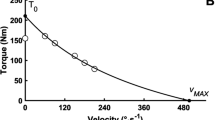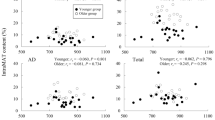Abstract
BACKGROUND:
Motor capabilities are reduced in obese (OB) individuals, and this impairment may result also from quantitative variation of muscle mass due to alterations in body composition.
OBJECTIVE:
This study aims to evaluate the differences in body mass (BM) and composition, as well as in muscle strength (ST) and power output (Ẇ) between OB and NW males and females, and to test the hypothesis that variations in body composition affect muscle performance in OB subjects.
DESIGN AND METHODS:
Body composition (determined by BIA with a two-compartment model), upper and lower limb maximum ST (evaluated with isotonic machines) and lower limb maximum anaerobic Ẇ (measured with a jumping test) were studied in a group of 95 extremely OB subjects (OB: 28 males, 67 females; mean age±s.d.: 29.3±7.0 y; BMI: 41.2±4.4 kg/m2) and in a control group of 18 NW voluntary subjects (NW: eight males, 10 females; age: 30.3±5.3 y; BMI: 22.6±2.1 kg/m2).
RESULTS:
OB male and female subjects differed significantly with increases in BM being attained by a similar contribution of fat mass (FM) and fat-free mass (FFM) in male subjects, but mainly contributed by FM in female subjects. Compared with NW, both OB men and women had a greater amount of FFM (P<0.001) and, since a general linear correlation was found between ST and FFM (ST (N)=64.4 FFM (kg)−190.0, R2=0.612, P<0.001), they developed higher values of ST (P<0.05) than their respective NW counterparts. For the same reason, both OB and NW male subjects had higher ST (P<0.001) than their female counterparts. Correction for FFM eliminated all gender- and obesity-related ST differences. On the contrary, in spite of their higher absolute muscle strength, both OB men and women could develop absolute Ẇ similar to that of NW subjects, and were notably less powerful per unit BM than NW subjects (P<0.001), women being most affected among the OB.
CONCLUSIONS:
Obesity-related variation in body composition differs considerably by gender, and is responsible for differences in muscle performance: the higher muscle strength observed in OB subjects (both men and women) and in male subjects (both OB and NW) is accounted for by a greater amount of FFM. Nonetheless, biomechanical limitations appear to impair muscle power development during jumping in OB individuals.
This is a preview of subscription content, access via your institution
Access options
Subscribe to this journal
Receive 12 print issues and online access
$259.00 per year
only $21.58 per issue
Buy this article
- Purchase on Springer Link
- Instant access to full article PDF
Prices may be subject to local taxes which are calculated during checkout





Similar content being viewed by others
References
Flegal KM . The obesity epidemic in children and adults: current evidence and research issues. Med Sci Sports Exer 1999; 31: S509–S514.
Mokdad AH, Serdula MK, Dietz WH, Bowman BA, Marks JS, Koplan JP . The continuing epidemic of obesity in the United States. JAMA 2000; 284: 1650–1651.
Must A, Spadano J, Coakley EH, Field AE, Colditz G, Dietz WH . The disease burden associated with overweight and obesity. JAMA 1999; 282: 1523–1529.
Visscher TLS, Seidell JC . The public health impact of obesity. Annu Rev Public Health 2001; 22: 355–375.
Han TS, Tijhuis MA, Lean ME, Seidall JC . Quality of life in relation to overweight and body fat distribution. Am J Public Health 1998; 88: 1814–1820.
Doll HA, Petersen SEK, Stewart-Brown SL . Obesity and physical and emotional well-being: association between body mass index, chronic illness, and the physical and mental components of the SF-36 questionnaire. Obes Res 2000; 8: 160–170.
Larsson U, Karlsson J, Sullivan M . Impact of overweight and obesity on health-related quality of life—a Swedish population study. Int J Obes Relat Metab Disord 2002; 26: 417–424.
Barofsky I, Fontaine KR, Cheskin LJ . Pain in the obese: impact on health-related quality-of-life. Ann Behav Med 1997; 19: 408–410.
Hulens M, Vansant G, Lysens R, Claessens AL, Muls E . Exercise capacity in lean versus obese women. Scand J Med Sci Sports 2001; 11: 305–309.
Lafortuna CL, Fumagalli E, Vangeli V, Sartorio A . Lower limb alactic anaerobic power output assessed with different techniques in morbid obesity. J Endocrinol Invest 2002; 25: 134–141.
Sartorio A, Fontana P, Trecate L, Lafortuna CL . Short-term changes of fatigability and muscle performance in severe obese patients after an integrated body mass reduction program. Diabetes Nutr Metab 2003; 16: 88–93.
Sartorio A, Proietti M, Marinone PG, Agosti F, Adorni F, Lafortuna CL . Influence of gender, age and BMI on lower limb muscular power output in a large population of obese men and women. Int J Obes Relat Metab Disord 2004; 28: 91–98.
Evers Larsson U, Mattsson E . Functional limitations linked to high body mass index, age and current pain in obese women. Int J Obes Relat Metab Disord 2001; 25: 893–899.
Evers Larsson UE, Mattsson E . Perceived disability and observed functional limitations in obese women. Int J Obes Relat Metab Disord 2001; 25: 1705–1712.
Lafortuna CL, Agosti F, Marinone PG, Marazzi N, Sartorio A . The relationship between body composition and muscle power output in men and women with obesity. J Endocrinol Invest 2004; 27: 854–861.
Lukaski HC, Bolonchuk WW, Hall CB, Siders WA . Validation of tetrapolar bioelectrical measurements to assess human body composition. J Appl Physiol 1986; 60: 1327–1332.
Gray DS, Bray GA, Gemayel N, Kaplan K . Effects of obesity on bioelectrical impedance. Am J Clin Nutr 1989; 50: 255–260.
Mayhew JL, Prinster JL, Ware JS, Zimmer DL, Arabas JR, Bemben MG . Muscular endurance repetitions to predict bench press strength in men of different training levels. J Sports Med Phys Fitness 1995; 35: 108–113.
Bosco C, Luhtanen P, Komi PV . A simple method for measurement of mechanical power in jumping. Eur J Appl Physiol 1983; 50: 273–282.
Zar JH . Biostatistical analysis. Prentice-Hall International Editions: Englewood Cliffs, NJ, USA; 1984. pp 292–305.
Pietrobelli A, Heymsfield SB . Establishing body composition in obesity. J Endocrinol Invest 2002; 25: 884–892.
Bioelectrical Impedance Analysis in Body Composition Measurement. Proceedings of a National Institutes of Health Technology Assessment Conference. Bethesda, Maryland, December 12–14, 1994. Am J Clin Nutr 1996; 64: 387–532.
Das SK, Roberts SB, Kehayias JJ, Wang J, Hsu LK, Shikora SA, Saltzman E, McCrory MA . Body composition assessment in extreme obesity and after massive weight loss induced by gastric bypass surgery. Am J Physiol Endocrinol Metab 2003; 284: E1080–E1088.
Margetts BM, Rogers E, Widhal K, Remaut de Winter AM, Zunft HJ . Relationship between attitudes to health, body weight and physical activity and level of physical activity in a nationally representative sample in the European Union. Public Health Nutr 1999; 2: 97–103.
Centers for Disease Control and Prevention (CDC). Prevalence of no leisure-time physical activity-35 States and the District of Columbia, 1988–2002. MMWR Morb Mortal Wkly Rep 2004; 53: 82–86.33.
Ivey FM, Roth SM, Ferrell RE, Tracy BL, Lemmer JT, Hurlbut DE, Martel GF, Siegel EL, Fozard JL, Jeffrey Metter E, Fleg JL, Hurley BF . Effects of age, gender, and myostatin genotype on the hypertrophic response to heavy resistance strength training. J Gerontol A Biol Sci Med Sci 2000; 55: M641–M648.
Fryburg DA, Barrett EJ . Growth hormone acutely stimulates skeletal muscle but not whole-body protein synthesis in humans. Metabolism 1993; 42: 1223–1227.
Bjorntorp P . Body fat distribution, insulin resistance, and metabolic diseases. Nutrition 1997; 13: 795–803.
Roelen CA, Koppeschaar HP, de Vries WR, Snel YE, Doerga ME, Zelissen PM, Thijssen JH, Blankenstein MA . Visceral adipose tissue is associated with circulating high affinity growth hormone-binding protein. J Clin Endocrinol Metab 1997; 82: 760–764.
Llopis MA, Granada ML, Cuatrecasas G, Formiguera X, Sanchez-Planell L, Sanmarti A, Alastrue A, Rull M, Corominas A, Foz M . Growth hormone-binding protein directly depends on serum leptin levels in adults with different nutritional status. J Clin Endocrinol Metab 1998; 83: 2006–2011.
Rissanen P, Makimattila S, Vehmas T, Taavitsainen M, Rissanen A . Effect of weight loss and regional fat distribution on plasma leptin concentration in obese women. Int J Obes Relat Metab Disord 1999; 23: 645–649.
Bosy-Westphal A, Eichhorn C, Kutzner D, Illner K, Heller M, Müller MJ . The age related decline in resting energy expenditure in humans is due to loss of fat-free mass and to alterations in its metabolically active component. J Nutr 2003; 133: 2356–2362.
Chowdhury B, Sjöström L, Alpsten M, Kostanty J, Kvist H, Löfgren R . A multicompartment body composition technique based on computerized tomography. Int J Obes Relat Metab Disord 1994; 18: 219–234.
Ross R, Rissanen J, Pedwell H, Clifford J, Shragge P . Influence of diet and exercise on skeletal muscle and visceral adipose tissue in men. J Appl Physiol 1996; 81: 2445–2455.
Frontera WR, Hughes VA, Lutz KJ, Evans WJ . A cross-sectional study of muscle strength and mass in 45- to 78-yr-old men and women. J Appl Physiol 1991; 71: 644–650.
Bosco C, Rusko H, Hirvonen J . The effect of extra-load conditioning on muscle performance in athletes. Med Sci Sports Exerc 1986; 18: 415–419.
Davies CTM, Young K . Effects of external loading on short term power output in children and young male adults. Eur J Appl Physiol 1984; 52: 351–354.
Driss T, Vandewalle H, Quievre J, Miller C, Monod H . Effects of external loading on power output in a squat jump on a force platform: a comparison between strength and power athletes and sedentary individuals. J Sports Sci 2001; 19: 99–105.
Acknowledgements
The authors wish to thank Drs G Silvestri, A Tibaldi, M Resnik and PG Marinone for their clinical advice. Ms F Pera (headnurse) and the nursing staff at the 3rd Division of Metabolic Diseases supported the study with their professional skillfulness. Mr S Ottolini and M Proietti assisted in data-base management.
Author information
Authors and Affiliations
Corresponding author
Rights and permissions
About this article
Cite this article
Lafortuna, C., Maffiuletti, N., Agosti, F. et al. Gender variations of body composition, muscle strength and power output in morbid obesity. Int J Obes 29, 833–841 (2005). https://doi.org/10.1038/sj.ijo.0802955
Received:
Revised:
Accepted:
Published:
Issue Date:
DOI: https://doi.org/10.1038/sj.ijo.0802955
Keywords
This article is cited by
-
Gender and physical frailty modify the association between abdominal obesity and functional disability in older adults
Aging Clinical and Experimental Research (2022)
-
Comparison of gluteus medius strength between individuals with obesity and normal-weight individuals: a cross-sectional study
BMC Musculoskeletal Disorders (2021)
-
Full characterisation of knee extensors’ function in ageing: effect of sex and obesity
International Journal of Obesity (2021)
-
Static one-leg standing balance test as a screening tool for low muscle mass in healthy elderly women
Aging Clinical and Experimental Research (2021)
-
Attenuation of autonomic dysreflexia during functional electrical stimulation cycling by neuromuscular electrical stimulation training: case reports
Spinal Cord Series and Cases (2020)



